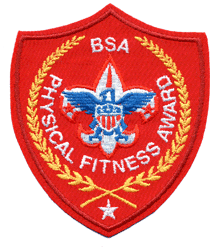The Seven Major
Components of Fitness
The BSA Physical Fitness Award's core
requirements are the following seven major components.
They are used to measure an individual's improvement over
time, not to establish an arbitrary minimum level of
activity.
- Posture
-
Posture is evaluated with a
posture-rating chart. The Scout or Scouter is compared
to a photo of his or her starting posture, noting 13
different body segments. Each body segment is scored
as a five, three, or one, making a possible range of
scores from 13 to 65. Higher scores over time reflect
improving posture.
- Accuracy
-
The target throw is used to measure
accuracy. The Scout or Scouter makes 20 throws with a
softball at a circular target and is scored on the
number of times the target is hit.
- Strength
-
The sit-up is used to measure
strength. The Scout or Scouter lies on his or her back
with knees bent and feet on the floor. The arms are
crossed on the chest with the hands on the opposite
shoulders. The feet are held by a partner to keep them
on the floor. Curl to the sitting position until the
elbows touch the thighs. Arms must remain on the chest
and chin tucked on the chest. Return to the starting
position, shoulder blades touching the floor. The
score is the number of sit-ups made in a given time.
- Agility
-
The side step is used to measure
agility. Starting from a center line, the Scout or
Scouter sidesteps alternately left and right between
two lines 8 feet apart. He or she is scored on the
number of lines crossed in 10 seconds.
- Speed
-
The dash is used to measure speed. The
score is the amount of time to the nearest half-second
running a set distance that can be increased each
year.
- Balance
-
The squat stand is used to measure
balance. The Scout or Scouter squats with hands on the
floor and elbows against the inner knee. He or she
leans forward until the feet are raised off the floor.
The score is the number of seconds held in that
position.
- Endurance
-
The squat thrust is used to measure
endurance. The Scout or Scouter starts from the
standing position. He or she performs the usual
four-position exercise. The score is the number of
completed squat thrusts made in a given time.
Some of these tests measure more than the
components they represent. For example, the sit-ups, a
measure of strength, also reflect some endurance because
of their repetition. The squat stand requires balance, its
major component, but also requires strength and endurance
to support the weight of the body on the arms. |
![]()